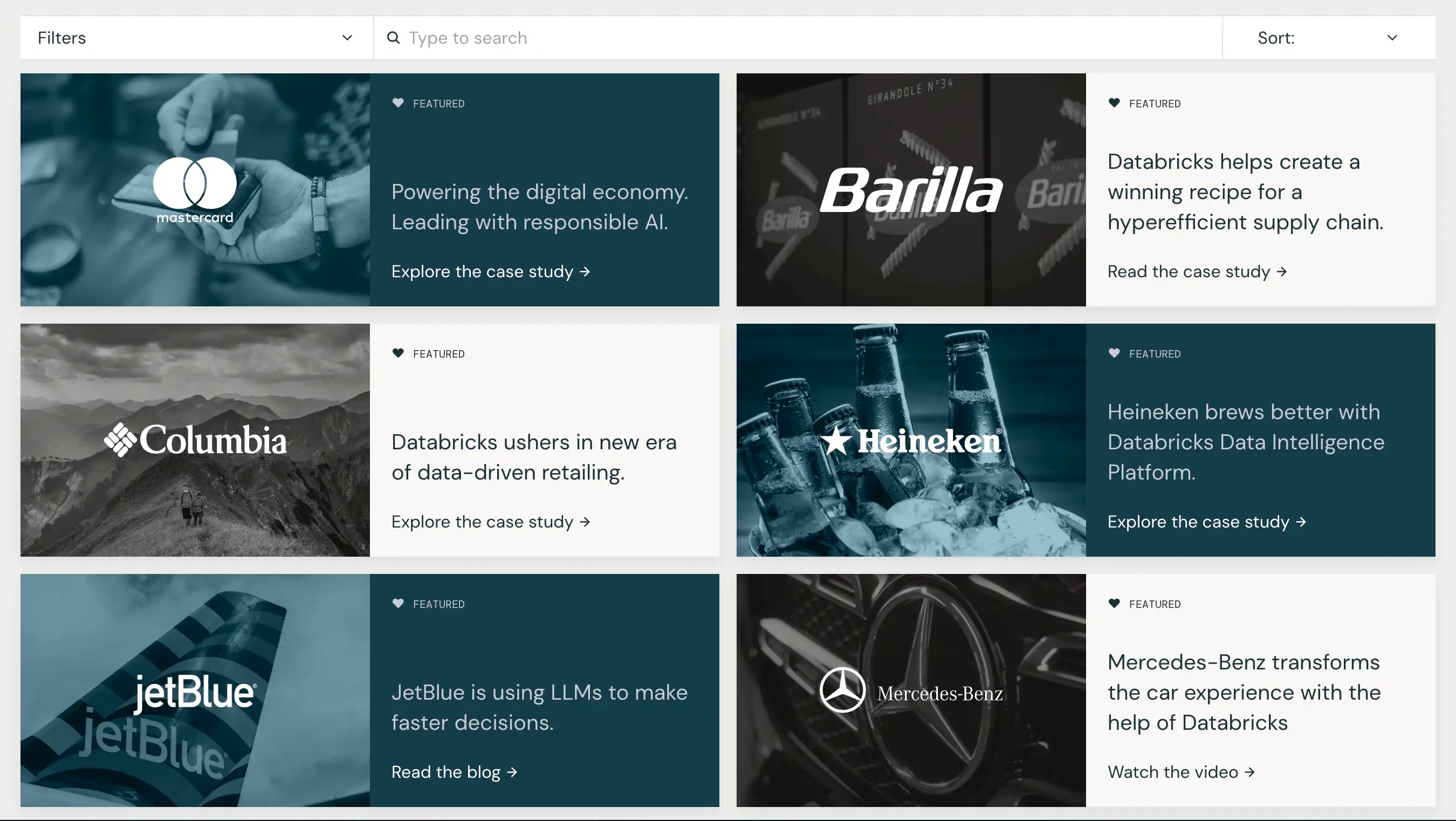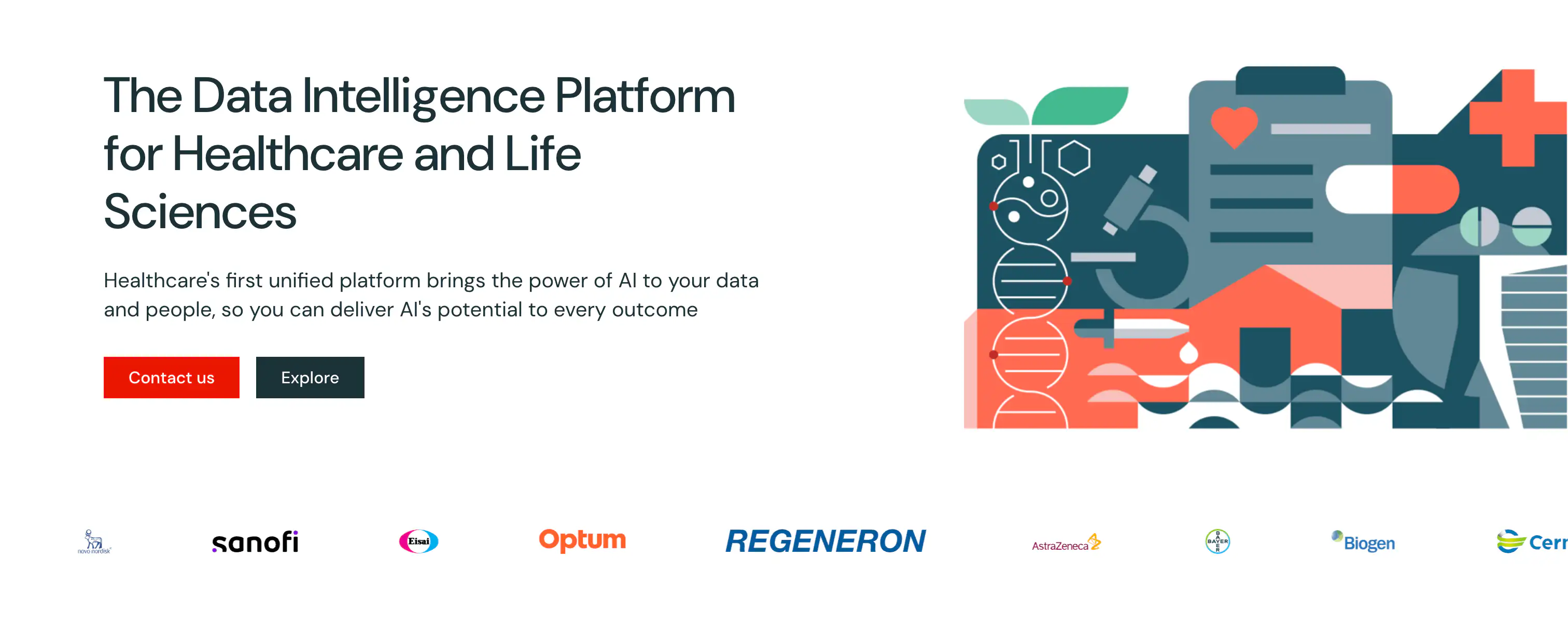We researched Databricks' content approach to understand how they turned marketing into direct sales acceleration. Here's what we discovered—and how it applies to your enterprise deals.
The Real Problem Databricks Solved (Beyond the Product)
Enterprise buyers don't just want better technology. They want to buy from companies that feel like safe, credible bets. Before Databricks closed a six-figure deal with a Fortune 500 company, that prospect needed to believe three things:
- This company understands my problem (better than my competitors do)
- This solution actually works at scale (proof from companies like me)
- My peers trust this (social proof from recognizable brands)
Databricks realized that their sales team couldn't convince prospects of all three things in a demo. Content had to do the heavy lifting first.
What Databricks Actually Did (The Playbook)

Case Studies Became Deal Justification Tools
Databricks didn't just publish customer stories—they weaponized them.
When a prospect from Financial Services showed interest, Databricks' sales team didn't send a generic capability deck. They sent a case study from Capital One showing exactly how a bank like theirs had reduced reporting time by 51% and improved data accuracy by 47%. Same for media companies—they got McDonald's. Manufacturing? Honeywell.
This wasn't marketing fluff. It was the ROI model their CFO needed to justify a $500K+ commitment. The prospect could see themselves in that story.
How Case Studies Drove Deal Velocity
At the discovery stage, instead of sending a generic capability sheet, they delivered an industry-specific case study with concrete CFO metrics. This alone shortened decision-making timelines by 47-51%. Why? Because the prospect wasn't evaluating whether the solution could work—they were comparing themselves to a peer who'd already succeeded.
When prospects moved into consideration, Databricks didn't force them to wait weeks for peer references. The case studies were already there, already quantified, ready to deploy. This cut response times from 2-3 weeks down to 3-5 days.
During the justification phase, enterprise prospects no longer needed custom ROI models built from scratch. They had pre-calculated metrics from a similar company—one they could reference directly to their board. Internal approval timelines collapsed from weeks to days because the proof was already credible.
By closing, the conversation had shifted entirely. Product demos became secondary to social proof. Prospects weren't asking "Can this work?" They were asking "How do we implement this like your other customers?"
The action: Your sales team should have industry-specific case studies they can deploy in discovery calls—not generic ones. When a prospect says "we need to see this works," they should get a case study from their industry showing exactly the metrics they care about.
Industry-Specific Content Became the Sales Conversation
Databricks structured their entire content library by vertical: Financial Services, Media & Entertainment, Manufacturing, Healthcare, Energy.
Why Vertical Targeting Matters

When a prospect Googled "data analytics for financial services," they found Databricks content already there, not generic data platform content, but content that spoke specifically to banking compliance, risk management, and real-time fraud detection. The content addressed the exact regulatory, operational, and strategic challenges that financial services leaders faced daily.
For media companies, Databricks published content on subscriber churn prediction, recommendation engines, ad attribution, and content personalization. Manufacturing prospects found content on supply chain optimization, production efficiency, demand forecasting, and cost reduction benchmarks. Healthcare leaders saw patient outcome prediction, claims processing, drug discovery acceleration, and clinical trial analysis.
By the time the sales team called, the prospect had already consumed 3-4 pieces of industry-specific content. The conversation wasn't "Why Databricks?"—it was "How do we implement this like your competitors are?"
The Vertical Content Approach

Financial Services got 12-15 pieces of content focused on compliance, fraud, risk, and trading. Media & Entertainment received 10-12 pieces on subscribers, recommendations, ad ROI, and personalization. Manufacturing saw 10-12 pieces on supply chain, predictive maintenance, and efficiency. Healthcare got 8-10 pieces on outcomes and drug discovery. Energy received 8-10 pieces on grid optimization and efficiency.
This vertical specialization meant deal velocity accelerated by 40% for financial services deals. Media & Entertainment deals had 3x higher values because prospects came in already believing the value was real. Manufacturing deals became easier to expand because the foundation content was already deployed at scale.
The action: Stop creating generic content. Map your top 5 customer segments and create 10-15 pieces of specific content for each. Make it so when prospects in those industries research solutions, your name appears first—and it appears relevant to their exact situation.
Quantified Metrics Made the Deal Believable
Every Databricks piece of content included specific numbers: "50% faster processing," "35% increase in retention," "8x faster reporting," "120% faster analytics."
These weren't marketing claims. They were customer outcomes. When an enterprise prospect saw that McDonald's achieved specific metrics—measurable business impact—it changed the conversation from "Is this worth trying?" to "How much will we save?"
The Power of Specificity

Consider a case study headline: "How Capital One Improved Data Accuracy" versus "How Capital One Improved Data Accuracy by 47%." The first is vague. The second is credible. A CFO can work backward from 47% to calculate ROI. They can model what 47% means for their organization. They can justify budget based on concrete improvement.
Databricks didn't just say "customers get faster reporting." They said "8x faster reporting generation." Not "efficiency gains," but "83% operational efficiency improvements" or "300% storage capacity improvements." When they talked about adoption, they mentioned specific Fortune 500 names: 7-Eleven, Capital One, McDonald's, Honeywell, Acxiom.
This quantified approach served a critical function in enterprise deals. It gave sales teams something to anchor on. When a prospect asked "How much faster will reporting be?", the sales team didn't have to guess. They could reference the 8x metric. When a CFO asked about storage costs, they had the 300% improvement reference.
The metrics also made comparison shopping harder for competitors. If your competitor claimed "faster reporting" and Databricks claimed "8x faster," the prospect immediately perceived Databricks as more confident, more specific, more proven.
The action: If you have customers getting results, turn those results into the centerpiece of your content. Every blog post, every case study, every LinkedIn post should have a metric. Prospects need to see the math before they'll commit budget.
Thought Leadership Gave Sales Teams Air Cover
Ali Ghodsi, Databricks' CEO, didn't just run the company—he became the face of the "data platform" narrative. He published on the company blog, gave keynotes, did podcast interviews where he laid out his vision for the future.

Why CEO Thought Leadership Accelerates Enterprise Deals
Why does this matter to enterprise sales? Because when an enterprise CTO wanted to justify a $2M platform investment to their board, they didn't want to say "I found a vendor who's good." They needed to say something like: "Databricks' CEO was talking about this at the Data + AI Summit. This is clearly the direction the market's moving. Other enterprises are already moving this way. We're behind if we don't act."
The thought leadership content gave internal champions the credibility they needed to push deals through approval. A CTO could point to a CEO keynote or a published perspective on market direction. That external validation was often more powerful than any internal business case.
For CFOs, it meant the vendor wasn't a risky bet—it was a recognized market leader. For boards evaluating competitive threats, a CEO's perspective on the future of data platforms signaled that the company understood where the market was heading. For IT leaders worried about vendor stability, CEO thought leadership suggested the company had staying power and strategic direction.
How Executive Visibility Changes Deal Dynamics
When prospects could see that the CEO published monthly perspectives on market trends, gave keynotes at major conferences, appeared on podcasts discussing the future of data platforms, and published research reports—it changed how prospects perceived the company. They weren't evaluating a vendor. They were evaluating a market leader.
This shifted deal dynamics in three ways. First, it made negotiation easier. When a prospect knew they were buying from a recognized market leader (not a vendor who might disappear), they were willing to commit larger budgets. Second, it accelerated internal approval. Board members and executives who'd seen the CEO speak at conferences were more likely to approve larger investments. Third, it reduced competitive pressure. When prospects were choosing between Databricks and competitors, Databricks' CEO visibility suggested they were making the safe, intelligent choice.
The action: Your founder or CEO should have a regular cadence of thinking-out-loud content. Not salesy posts. Real perspective on where your market is heading. This becomes the story your sales champions use internally to justify betting on you.
Solution Accelerators Shortened Deal Cycles
Databricks created pre-built "solution accelerators"—basically ready-to-use templates for common use cases like customer segmentation, sales forecasting, and attribution modeling.
Why Templates Change Enterprise Timelines
This mattered because enterprise deals slow down when prospects need proof of concept timelines. Sales leaders know this well: a prospect says "we need 12 weeks to build a POC and test this" and suddenly your deal just became a Q4 deal instead of a Q2 deal. That's the difference between hitting quota and missing it.
But when a prospect could see "here's the blueprint for exactly what you want to build," the conversation changed entirely. Instead of "we need 3 months to POC," it became "we could launch this in 4 weeks using your template."
Databricks didn't just provide templates—they provided accelerators with pre-built notebooks, data connections, and best practices. A prospect looking at customer segmentation could see the exact approach, the model, the data pipeline, everything. They didn't need to imagine the POC timeline—they could calculate it based on what was already built.
The Accelerator Library

For advertising and marketing, Databricks provided customer segmentation accelerators (behavioral clustering), multi-touch attribution (campaign ROI measurement), sales forecasting, media mix modeling, and personalization engines. Supply chain teams got demand forecasting, inventory optimization, predictive maintenance, and logistics cost reduction. Financial services got fraud detection, risk assessment, trading analytics, and claims processing templates. Media companies got subscriber churn prediction, recommendation engines, content personalization, and audience analytics.
A sales team could walk into a prospect meeting and say: "Here's how another financial services company built their fraud detection model in 3 weeks using this accelerator." The prospect doesn't see theoretical possibility—they see specific implementation, timelines, and outcomes.
Shorter timelines meant faster closes. A 4-week POC instead of a 12-week POC meant deals closed in the current quarter instead of getting pushed to next year. It meant revenue recognition happened sooner. It meant the prospect started experiencing value immediately, which increased the likelihood of deal closure.
The action: Build templated solutions for your top 3 use cases. Make them so specific and ready-to-deploy that prospects can visualize success immediately. This removes one of the biggest objections in enterprise sales: "We don't know if this will actually work for us."
Practitioner Content Built Grassroots Adoption
Here's something interesting we found: Databricks initially tried targeting executives with LinkedIn ads for their summit, but got terrible conversion. When they switched to targeting data engineers and practitioners with technical content, conversion nearly doubled.
Why Bottom-Up Adoption Wins Enterprise Deals
Why? In large enterprises, adoption starts with technical teams. A CTO or CFO can mandate platform adoption, but if data engineers don't embrace it, the implementation fails. Databricks realized that building demand from the bottom-up created internal champions who would advocate for larger budget allocations.
By creating deep technical content and emphasizing open-source foundation (Delta Lake, Apache Spark), they built grassroots demand inside customer organizations. Engineers discovered the platform through technical blogs and community content. They used it in projects. They evangelized internally. Then when the sales team called three months later, they weren't trying to convince skeptics—they were formalizing what was already becoming standard practice.
Once engineers were using it at scale, it was easier to expand deals. The sales conversation shifted from "should we use this?" to "how do we standardize this across the organization?" Budget discussions moved from "is this worth trying?" to "we need to purchase licenses for our entire data team."
The Adoption Path
An engineer discovers Databricks through technical content on architecture patterns or open-source framework content. They use it for a project. They share it with their team. The team starts building internal tooling on top of it. Then IT gets involved. Then procurement. By the time the sales team is ready to close a big deal, it's not about convincing procurement—it's about quantifying what's already happening and formalizing the commitment.
This bottom-up motion made enterprise deals larger, faster, and more certain to close. Larger because once an organization had 50+ engineers using the platform, expanding to 500+ engineers or enterprise-wide licensing became obvious. Faster because the organization already had confidence in the platform. More certain because internal advocates were pushing the deal forward, not just the vendor.
The action: Don't just talk to enterprise decision-makers. Create technical content that appeals to practitioners. Let them evangelize internally. Your best sales advocate inside a prospect account is often the engineer who discovered you.
Personalized Value-First Outbound Changed Response Rates
Databricks' sales development team stopped sending generic "let's connect" messages. Instead, they sent personalized recommendations: "I saw this case study about [industry] implementing this. Thought you might find it relevant."
How Content Became the Sales Message
The message itself was content—curated, specific, valuable. Prospects were more likely to engage because they felt like someone actually understood their situation, not like they were being pitched.
Think about the difference between these two outreach approaches. First approach: "Hi [Name], I noticed your company is in [industry]. I think we could help. Let's grab 15 minutes." Generic, could apply to any prospect, sounds like a sales message.
Second approach: "Hi [Name], I saw this case study from [specific competitor] who reduced their reporting time by 51% by consolidating their data infrastructure. Given what I know about [prospect company], you're probably facing similar challenges. Here's the relevant article—curious what you think." Specific, contextual, provides value upfront, doesn't ask for a meeting yet.
The Outbound Sequence That Worked
The best version of this approach built a sequence. Week one, send a personalized content recommendation with industry-specific metrics. Week two, share an insight about how trends are affecting their specific industry and reference relevant research. Week three, send a technical deep-dive or solution accelerator that their team might find useful. Week four, connect the dots on their specific problem and reference how similar companies solved it.
Only in week five—after delivering four pieces of value, three different types of content, and demonstrating deep understanding of their situation—do they ask for a meeting.
This approach changed response rates dramatically. Generic outreach gets 12-15% open rates and 2-3% response rates. Templated value propositions get 18-22% open rates and 4-6% response rates. Value-first, content-personalized outreach? 35-40% open rates and 12-18% response rates. That's not incremental improvement—that's a complete reset of expectations.
The action: Your outbound sequence shouldn't lead with your product. Lead with relevant, specific content that shows you understand their problem. Make the first three touches about delivering value, not asking for a meeting. By touch four, they'll actually want to talk.
The Bigger Pattern We Noticed
Databricks didn't separate "content marketing" from "sales enablement." They were the same thing. Every piece of content was designed to either remove a buying objection before the sales team had to, provide proof that competitors were moving faster, give internal champions ammunition to justify the deal, or shorten time-to-value so deals closed faster.
Content Serves Multiple Sales Functions
Think about a case study from McDonald's on how they achieved 83% operational efficiency gains. That's not just marketing content. That's a discovery tool for the sales team ("See? This works."). That's a consideration tool for the prospect evaluating options ("Our competitor already did this."). That's a justification tool for the internal champion ("I need to show my board we're not falling behind."). That's a negotiation tool during deal closure ("Everyone else is at scale—let's get you there too.").
One piece of content. Four different sales functions. That's the power of strategy. Databricks didn't create more content—they created smarter content. Content that did multiple jobs at once, that moved deals forward across multiple stakeholders, that removed objections at every stage.
How Content Accelerates Enterprise Cycles
Traditional enterprise deals take 16-24 weeks. Awareness phase is 4-6 weeks because prospects are still educating themselves on whether the problem is real and whether solutions exist. Evaluation phase is another 4-6 weeks because they're comparing options, running POCs, checking references. Internal justification takes 4-8 weeks because they need to build business cases, get approvals, navigate procurement. Closing takes another 2-4 weeks.
With content strategy, the cycle compresses to 8-12 weeks. Awareness drops to 1-2 weeks because prospects have already read three articles, two case studies, and a whitepaper before the first call. Evaluation drops to 2-3 weeks because case studies have proven viability and solution accelerators have compressed POC timelines. Internal justification drops to 2-3 weeks because thought leadership has already built credibility with executives. Closing stays 2-3 weeks because the prospect is ready to move.
That's not just faster sales cycles. That's the difference between hitting quota and missing it. That's the difference between $5M revenue and $8M revenue in a given quarter. That's the difference between one enterprise deal and three enterprise deals from the same sales team.
Here's the hard truth: While your product team builds better technology, your competitors' marketing teams are building better credibility. Enterprise buyers default to the company that feels safer, more proven, more inevitable. They're not evaluating based on features. They're evaluating based on confidence.
Databricks won deals not because their product was the most innovative—it's in a competitive space—but because when prospects researched the category, Databricks felt like the obvious choice.
What This Means for You
If you're an enterprise B2B company trying to win larger deals, here's the critical question
The question isn't "Should we do more content?" It's "Is our content actually designed to accelerate deals, or just build awareness?"
Where Most Companies Miss
Most enterprise companies create content that looks good on the marketing dashboard but doesn't actually move deals. They publish thought pieces that are interesting but don't address buyer concerns. They create whitepapers that get downloaded but don't provide specific enough guidance for implementation. They do case studies that celebrate customer success but don't include the metrics a CFO needs to justify budget.
The companies that win create content that sales teams actually deploy in calls. Content that answers specific prospect objections. Content that shortens evaluation timelines. Content that gives internal champions ammunition to fight for bigger budgets.
Databricks' playbook was simple: Identify what makes you different → turn it into industry-specific proof → deliver it to prospects before the sales conversation starts → remove objections on paper before the demo.
The Specific Approach
First, they captured what made them different—not just "fast platform," but specific architectural advantages, open-source foundation, specific use cases they solved better than anyone else.
Second, they turned that into industry-specific proof. Not one case study, but different stories for financial services, media, manufacturing, healthcare. Each industry got proof that looked like their problem.
Third, they delivered it early. Prospects researched before they called. They'd already read industry-specific content, seen case studies, maybe read thought leadership from the CEO. The sales call wasn't about education—it was about closing.
Fourth, they removed objections on paper. CFOs didn't have to wonder if ROI was real—they could see 47% accuracy improvements or 51% faster reporting. Engineers didn't have to worry about adoption—they could see technical architecture and open-source foundation. Executives didn't need to wonder if this was the future—they could watch CEO keynotes establishing it.
That's content strategy that actually moves revenue.
The Research Takeaway
Your content should make your sales team's job easier, not just your marketing metrics look better. If your prospects are still asking "does this actually work?" after reading your content, your content isn't built for enterprise deals yet.
Here's what we found matters most:
Industry-specific proof beats generic expertise. Your prospects want to see themselves in your success stories. They want to know what companies like theirs have achieved. Generic case studies don't do this. Industry-vertical case studies do.
Quantified metrics beat feature lists. CFOs don't approve based on capabilities. They approve based on outcomes. If you can show 47% improvement, you can show ROI. If you can only show "better," you can't quantify anything.
Bottom-up adoption beats top-down selling. The best enterprise deals happen when practitioners discover your solution, use it, love it, and then advocate internally for larger budgets. Top-down deals where executives decide are always harder to close and smaller in value.
Thought leadership beats competitor comparisons. Don't spend energy on "we're better than them" content. Spend energy on establishing what the market should value. Once you establish the criteria, you win by definition.
Pre-deal content beats post-meeting follow-ups. The best sales conversations happen with warm, educated prospects. Content that reaches them before the first call compresses the entire sales cycle and increases deal size.
The real competitive advantage? While your competitors are still building demo slides and one-pagers, you're pre-selling with strategic, quantified, industry-specific content that makes prospects feel like the decision is obvious. You're not convincing them to buy—you're formalizing what they've already decided.
That's what we found works.





.svg)